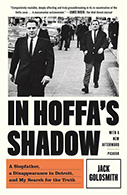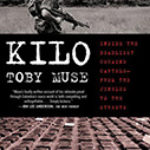In Hoffa’s Shadow: A Stepfather, a Disappearance in Detroit, and my Search for the Truth

Author: Jack Goldsmith
Publisher: Farrar, Straus and Giroux, 2019. 368 pages
Reviewer: Frederick T. Martens ǀ November 2021
There are few missing person investigations that are more indelibly woven into our cultural psych than that of the late James Riddle Hoffa, aka “Jimmy Hoffa.” Harvard law professor and renowned author Jack Goldsmith, having unfettered access to one of the principal suspects in the investigation, laments, “for two years the government had conducted the most extensive investigation in its history for someone believed to be dead” (p.249).
The legendary president of the most powerful labor union in the country for a half century, the International Brotherhood of Teamsters, Hoffa was abducted on July 30, 1975. He has never been seen again. Over the past four decades, at least twenty books, any number of newspaper articles, and three movies — The Irishman (2019) being the latest and most egregiously misleading — have opined on what really happened on that fateful summer day.
Now we are privy to the personal conversations of Jack Goldsmith, a former attorney in the U.S. Justice Department and his stepfather, Charles “Chuckie” O’Brien, who was alleged to have conspired with the Cosa Nostra in Hoffa’s disappearance.
As a former organized crime detective in New Jersey during Hoffa’s disappearance, it is this reviewer’s view that it was and remains the educated consensus that it was the late Anthony Provenzano, the labor leader of Teamster’s Local 560, and Salvatore Briguglio, the “hit-man,” and one Anthony Giacalone, who were the principal architects and contract executioners of Hoffa. Accordingly, Goldsmith speculates that “while the FBI believed that Giacalone and Provenzano organized this hit and used Chuckie [O’Brien] as their instrument, they didn’t understand the precise motive” (p. 240).
Goldsmith’s commendable efforts to absolve O’Brien of any involvement in Hoffa’s disappearance can be summed up by one memorable event that O’Brien claims occurred in Florida in September 1975—two months after Hoffa disappeared. Goldsmith contends that in a meeting with Provenzano and Giacalone, O’Brien “came away believing that Provenzano ‘had a lot to do with it…Pro was telling Chuckie to keep his mouth shut about what he learned in the run-up to the disappearance, whatever he had learned since, and anything else about the outfit…Pro was telling Chuckie to keep quiet or Provenzano would have him killed’” (pp. 241-242).
Subscribing to the classic modus operandi of the mafia, had O’Brien been involved in the disappearance of Hoffa, it is doubtful he would have lived to tell his step-son, Goldsmith, this incriminating and intimately revealing detail. This is perhaps the most compelling inference that can be drawn from the 333 pages that comprise Goldsmith’s legal brief.
There are, however, numerous morsels to be gleaned from Goldsmith’s treatise. For example, he suggests than an unintended consequence of the prosecution of Hoffa by then Attorney General Robert Kennedy was “a decade of much greater LCN (Cosa Nostra) dominance of the Teamsters union than anything that happened before” (pp. 249-250).
Illuminating the outsized and national role of New York’s so-called “Five Families,” Goldsmith believes that the aforementioned Giacalone “used his considerable influence at the top [i.e., the Commission and/or the Genovese Family, in order that] …Chuckie came under ‘New York protection,’” referring to the Cosa Nostra (p.251).
Why would O’Brien need protection when he, like Briguglio, could easily have been silenced, thereby eliminating any threat once and for all? This is where the plot thickens, and even begins to take on mythical proportions and outlandish contortions.
Goldsmith proposes several explanations: perhaps Giacalone’s “love for Chuckie” motivated him to go to the Five Families or the Commission and seek a sort of pardon for O’Brien; or Giacalone had “confidence in Chuckie’s Omerta commitment”; or it was a “calculated move by LCN to deflect attention from the real culprits” (p. 251).
None of these explanations seem credible —at least to those who have spent decades investigating and prosecuting Cosa Nostra families. To reiterate what one former FBI agent allegedly stated, “[t]hese Mafia guys would kill you over a bone with no more remorse than a crocodile” (p. 251). Clearly, “Chuckie could speak out with impunity [because] he was not involved in the disappearance, and he had permission to clear his name,” Goldsmith contends. This seems like an opinion that is shoe-horned into Goldsmith’s legal analysis (p. 252).
Ironically and paradoxically, Goldsmith apparently believes that the “deep state” —the FBI in concert with the media— created a false narrative in this case. He writes: “In America can a man be guilty until proven innocent?… Suppose you picked up this morning’s newspaper and your life was a front page headline…and everything they said was accurate. But none of it was true. This was exactly how Chuckie (O’Brien) felt” (p. 254).
Employing his “deep state” theory and this state’s alleged unwillingness to share evidence and information forty-four years later, Goldsmith cites electronically-surveilled conversations during a two-day trip taken by O’Brien and Vito Giacalone, the younger brother of aforementioned Anthony. An analysis of these conversations by an FBI agent concluded that the agent was “absolutely convinced beyond possible doubt” that Chuckie was not involved in Hoffa’s disappearance. It was O’Brien’s conclusion that the “CIA had knocked off Hoffa” (p. 258).
The author reiterates a number of possible motives for the disappearance of Hoffa. “Some have speculated that the mob knocked off Hoffa because he was going to spill the beans on what he knew to the Church Committee [US Senate committee formed to investigate CIA abuses] … There is no evidence for this theory…,” Goldsmith concludes (p. 259). He contends that O’Brien told him that Hoffa was knocked off not just because of his knowledge of the plots to assassinate Cuban leader Fidel Castro, but also because he was involved in CIA efforts to discredit the Kennedy brothers. He disposes of this theory as well, saying, “[t]his was all made up” (p. 259).
Goldsmith acknowledges that O’Brien told him “Hoffa wasn’t to his knowledge involved in any way with the Cuban assassination schemes, though he did play a role in arranging arms and munitions for his Mafia friends to give to the Cubans in the early 1960’s.” This has some plausibility given later congressional investigations.
There is a running theme throughout the book that simply puts the FBI and Justice Department hierarchy in Goldsmith’s cross-hairs. For example, citing the government reneging on its arrangement with O’Brien to exonerate him if he took a polygraph and passed, Goldsmith claims the government “acted outrageously…representing after the interview (of O’Brien) that he did well and that the exoneration was forthcoming” (p. 285). This did not happen.
Interestingly, O’Brien ultimately admits that he misled Goldsmith, which would seem to taint many of the conversations that Goldsmith relies upon to advance his legal analysis. As is often the case, when one act of deception is uncovered, it would seem that one should question how many other times you were misled, or how many other acts of deception you may have overlooked.
When all is said and done, the Hoffa investigation suffered from deceptive and ethically-challenged investigative practices, mass media hysteria and distortions, and of course, revisionist plots that make assumptions that can often be misleading.
Goldsmith’s attempt to bring clarity to the singular issue of O’Brien’s non-involvement in the disappearance of Hoffa provides a detailed analysis of the volumes of information that have been generated over the past several decades. Complimented with a first-person account from a principal spectator to this event, the most compelling argument for his stepfather’s non-culpability that Goldsmith can make is simply, O’Brien lived out his life, not in the witness protection program, but on the streets of Florida!
Frederick T. Martens is a retired detective/lieutenant in the New Jersey State Police; former Executive Director of the Pennsylvania Crime Commission; and a past president of the International Association for the Study of Organized Crime. (IASOC).


